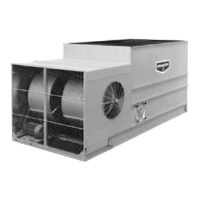19
Operation and Maintenance Instructions
Soft Water
The use of soft water with a galvanized steel unit is not recommended. Soft water is corrosive to galvanized steel.
In general, both Type 304 and Type 316 stainless steel exhibit good corrosion resistance to soft water. However, soft water is
usually generated from water softeners which typically use a brine solution (concentrated salt water) to regenerate. After
regeneration, this brine is flushed. If the softener is out of adjustment, not all the brine will flush out and this salt (NaCl) will be
carried out with the finished water. This poses the risk of high chlorides in the unitʼs recirculated water. Type 304 stainless steel is
susceptible to corrosion at high chloride levels. Type 316 stainless steel is more resistant to this corrosion.
Gray Water
Gray water is broadly defined as any water that has been used in a home or commercial environment, except water from toilets.
The use of gray water can be considered as long as the water chemistry conforms to the parameters found in the Water Treatment
section of this bulletin and understanding the risks of fouling or biological contamination when gray water is used. Gray water
should be avoided unless all of the risks are understood and taken into account.
Stainless Steel
Stainless steel is the most cost effective material of construction available to extend the life of an evaporative cooling unit.
The stainless steel sheet material utilized by EVAPCO is Type 304 and Type 316 with a No. 2B unpolished finish. Type 304
stainless steel is a basic chromium-nickel austenitic stainless steel and is suitable for a wide range of applications. It is readily
available throughout the world and is easy to form during the fabrication process. Type 316 stainless steel offers more corrosion
resistance than Type 304 due to the addition of molybdenum and a higher nickel content, which provides greater resistance to
pitting and crevice corrosion in the presence of chlorides. As a result, Type 316 stainless steel is desirable in heavy industrial,
marine environments and where make up water quality requires it.
Stainless steel provides its superior corrosion resistance by developing a surface film of chromium oxide during the manufacturing
process. In order to ensure maximum corrosion protection, stainless steel must be kept clean and have an adequate supply of
oxygen to combine with the chromium in the stainless steel to form “chromium-oxide”, a protective passivation layer. The protective
layer of chromium-oxide develops during routine exposure to the oxygen content in the atmosphere. This occurs during the milling
process and continuously as the stainless is formed and shaped for its final use.
Maintaining the Appearance of Stainless Steel
It is a common misconception that stainless steel is stain and rust proof, making surface maintenance not required at all. This is
simply not true. Like mill galvanized steel, stainless steel is most effective when kept clean. This is especially true when located in
atmospheres with chloride salts, sulfides or other rusting metals. In these environments, stainless steel can discolor, rust or
corrode.
Once the unit arrives at the job site, the most effective way of maintaining the stainless steel finish is to keep it clean! At a
minimum, the unit should be washed down annually to reduce residual dirt or surface deposits on the stainless steel. In addition,
this wash down will keep the stainless steel components free from the corrosive elements in the atmosphere including chlorides
and sulfides which are damaging to stainless steel.
Protect stainless steel during unit installation, especially welding of nearby carbon steel pipes as weld stag or other corroding
materials may cause staining in stainless shell if not protected or cleaned.

